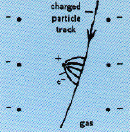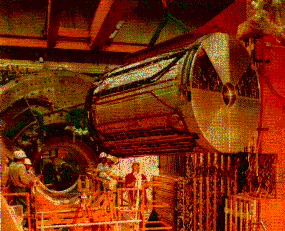| HERA |
| ZEUS |
| Tracking |
| Calorimetry |
| Next |
| Previous |
Tracking Detector
The tracking detctor works on the principle that a charged particle ionises gas when is passes through it. Tracking detectors consist of chambers that contain thousands of thin wires surrounded by a suitable gas. Some of these wires (anodes) are sense wires and the rest are cathodes to create an electrostatic field. When a charged particle ionises the gas surrounding the wires, the resultant electrons and ions drift towards the respective wires and produce a signal. The signals produced by the detector during an event can be used to reconstruct the paths the particles took through the chamber..
 |
|
||
| This picture shows the central tracking detector being lowered into place within the ZEUS detector. |
 |